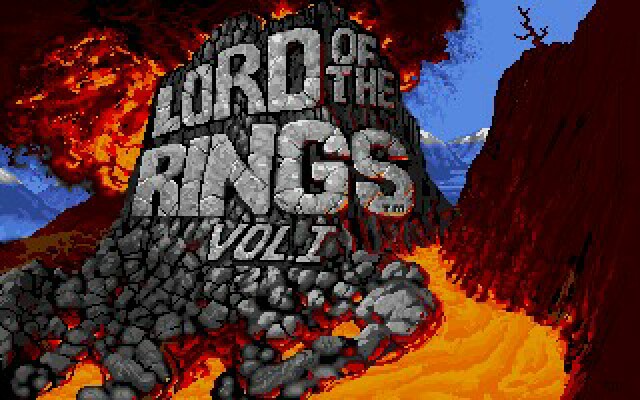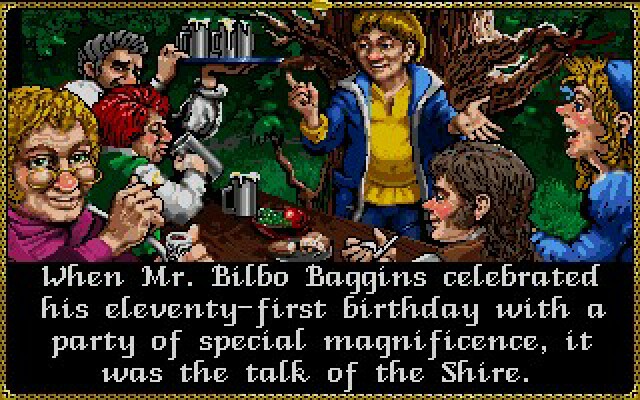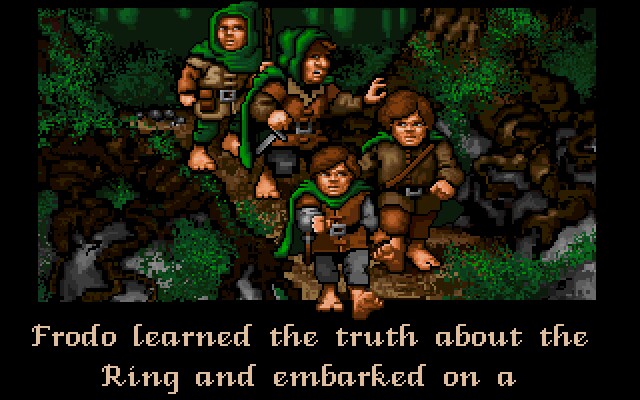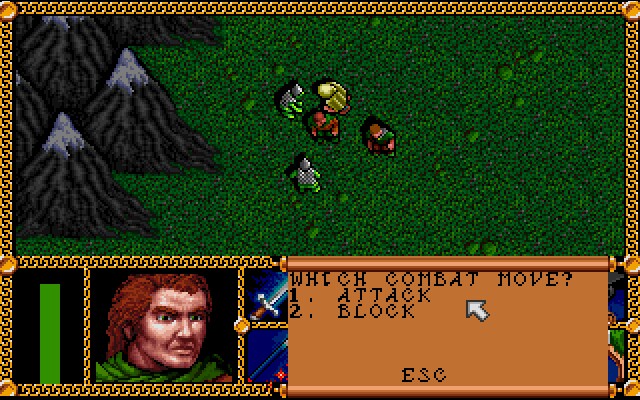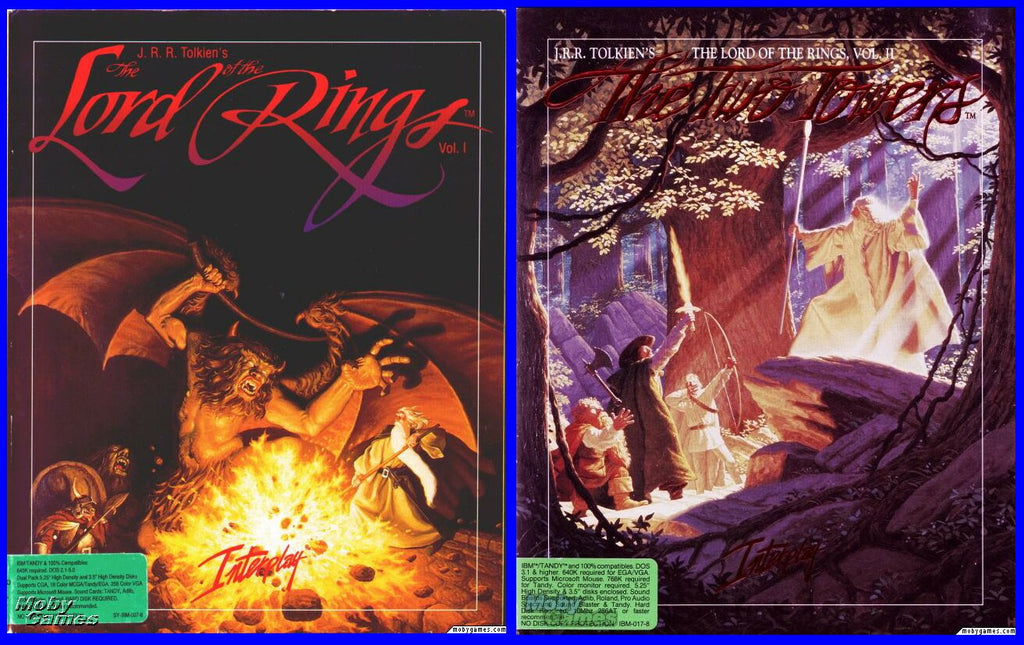
LORD OF THE RINGS & TWO TOWERS INTERPLAY +1Clk Macintosh OSX Install
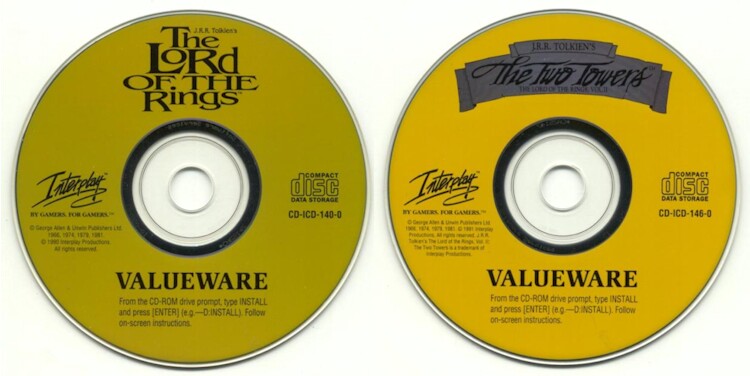
Actual Games
The Lord of the Rings
|
The Games
The Lord of the Rings
If you have played the floppy version of LOTR keep in mind the enhanced version contains 20 minutes of footage from Ralph Bakshi's animated version of The Lord of the Rings. The CD version also includes a nice stereo CD soundtrack that could not fit onto the floppy version.
Without a doubt, J.R.R. Tolkien's The Lord of the Rings is the basis for the popularity of modern fantasy, both in fiction and in role-playing games (RPG's). Drawing on myths, legends, folklore, and his own vivid imagination, Tolkien created a fantasy world that people could easily care about. Tolkien's work inspired a host of imitations in both the literary and gaming worlds; but while literary imitations have ranged from the horrendous to the very good, games have almost universally failed to reflect the care that went into Tolkien's work. Today's crop of spin-offs from Peter Jackson's movies are no exception. I find their relentless combat and Pavlovian arcade style offensive and contrary to the books.
The opposite is true in Interplay's The Lord of the Rings, a forgotten classic from 1990, and that's why it is undeniably special, even today. Unlike other computer games based on Tolkien's world, Interplay focused on recreating the detail and communicating the sheer love that went into the written work. In the process, this game also managed to take a completely fresh approach to the nature of computer role-playing games. Both accomplishments are worthy and welcome.
Like most Interplay games of the era, the interface is easy to use and the graphics are strong. You see the members of the fellowship trudging from place to place as you cross bridges, enter buildings, and climb hills in realistically rendered settings. From the map screen you can bring up the options menu, where you can load and save games, pause the action, stop the music, or quit the program. If you want the real stuff to happen, though, you must press the space bar and bring up the character menus.
From the character menu you can view the character's stats, cast magic spells, equip or trade items, talk to characters, use inventory items, or change leaders. Each action requires a single keystroke, which either does nothing or yields another menu. From this nested menu, another single keystroke accomplishes the action. Simple and elegant, the system handles some surprisingly complex situations. You also use this nested menu to engage in combat. Conducting battle is simply a matter of moving each character into position and either casting spells or attacking with fists, knives, swords, or axes.
You lose life points when you're hit, and your enemy loses them when you hit him. It's all very simple, and very easy to use. And this is, of course, in keeping with the Tolkien books. The current crop of games want combat regularly, but in Tolkien's trilogy it doesn't happen much at all. In Interplay's adaptation, as in the trilogy, combat is quite rare. It's possible to travel a long while without engaging in combat, and most fights are those you've sought yourself. In many cases, you can avoid combat by uttering the right password or showing the right item — and it's almost always better to do so.
Unlike most fantasy PPG's, The Lord of the Rings doesn't link gaining items with defeating enemies, so you can collect important artifacts without going through the ritual of battling foes. Monsters in this game don't carry treasure chests. For that matter, there aren't many monsters. You don't encounter 12 rabid rats, 6 zombies, or 8 Balrogs. Instead, you encounter a couple of wolves, an orc or two, the occasional human, and sometimes, and only when and where appropriate, magical creatures like barrow-wights and wizards. The effect of in-frequent combat is that the story carries far more suspense than you find in other fantasy PPG's. Another effect is that, once again, Interplay has captured the pace and feel of Tolkien's original trilogy.
The secret formula for Interplay's success, though, is attention to detail. You begin the game as Frodo, with Sam and Pippin standing with you in front of your hobbit-hole, Bag End. Before the game even starts, however, you're given a colorful summary of the first two chapters of Tolkien's book, and all details are accurate. Then you begin your journey, and nothing is omitted. In the Shire itself, for instance, you don't meet generic hobbits — you meet Lobelia, the Gaffer, and Farmer Maggot. Get through the Old Forest and you find Tom Bombadil and Goldberry, and in Bree you meet up with Strider and Barliman Butterbur. Bilbo, Arwen, and Elrohir await you in Rivendell, and you even come across Glorfindel on the road.
Interplay's adaptation also shines in its enhancements to Tolkien's story. Not wanting to put off a generation of Tolkien fans, the designers decided to add, very carefully, adventures not contained in the trilogy. Carefully is the key word here: Every added episode is either hinted at in the novels or clearly would have been possible in the Tolkien scheme.
In the Shire, for example, you meet the dwarf Druin, and in Buckland you come across Athelwyn the elf. Both will join your party, yet neither appears in the trilogy. Also in the Shire, you can take on several minor quests, ranging from finding a lost dog to rescuing two lost children among the ruins of the East Woods. After passing through the maze of the Old Forest you come across Bombadil, but you also meet the spirit of Withywindle the stream, and seek the aid of Ruddyoaks the tree. Both Withywindle and Ruddyoaks are discussed in the trilogy, but the game cleverly brings them to life. When Ruddyoaks joins your party, in fact, you are experiencing first-hand a bit of Tolkienesque magic. Truly excellent stuff.
Other clever side-adventures follow. A major addition to the plot involves the recovery of the Golden Wheel, a dwarfish artifact that's important for success. This plot, linked to the nature of the dwarves and Moria, is not in the trilogy, but it's appropriate to and very well-handled in the game. Little touches abound as well, such as Bilbo following you to the library in Rivendell and helping you find some essential scrolls. This is exactly the kind of thing Bilbo might have done, since he was fascinated by books and served as a constant source of information for Frodo.
The first part of this game takes place in the Shire and Buckland. Once through the many different adventures here, including a meeting with Gildor the Elf and a few other more surprising characters, the party must find its way through the Old Forest. The maze here is quite frustrating, but certainly no more than it was for the characters in the book. Past the Old Forest is Tom Bombadil's house, and after a series of fairly complex adventures, it's off to the event-filled Barrow-Downs. Eventually you'll find yourself lost in the fog, and when you emerge, you'll almost certainly be face to face with Sharkey's Shipping Store and the under-ground adventures that await you there. Then it's off to Bree, and eventually to Rivendell and beyond. This game takes you approximately to the end of the first volume of Tolkien's trilogy, and gives full treatment to all the major events that take place in the novel.
This game is a treasure for Tolkien fans. While no game can possibly capture the novels' sheer drawing power, Interplay's designers have done everything possible to capture the spirit of the books. And, faithful to the original work, they've minimized combat and maximized wonder, something long overdue in the fantasy PPG genre. If all goes well, playing this game will actually enhance your reading of the books, and there's nothing more you can ask.
The Two Towers
Even without the Tolkein backdrop Towers is a decent role-playing game. It includes cut scenes to switch from one party of the Fellowship to another. While the cut scenes are appropriate I wish there had been some warning so that I could have continued exploring or had the ability to switch parties manually. I was initially disappointed with the scope of Towers. It took me approximately 12 hours to complete the game; having read the book cut this time considerably. I later found that I had missed most of the adventure. There are many side quests which are not required in order to finish. These quests make up a considerable portion of the game. According to Interplay, the average playing time should be around 36 hours if all the quests are completed. Some Tolkein devotees may not like some of the additional quests and changes made to the story. The game follows the book fairly closely, but often the characters can reach their goals in a different manner than in the book. Of course, this is role playing not a book. There should be some latitude in reaching the goals. Overall, I found Towers to be very enjoyable as an RPG and a good adaptation of Tolkein's work. Even today I would recommend it to Tolkein fans or those adventurers who are willing to go back and explore even after finishing the game.
Towers is an RPG adaptation of the second book in the 'The Lord of the Rings" trilogy. It begins in the time following the breaking of the Fellowship. At the beginning, the Fellowship is made up of three separate parties. Frodo and Sam make up one party, Aragorn, Gimli, and Legolas make up another party. Merry and Pippin make up the third party. Each party has a different goal, though each is trying to thwart Sauron's plans. Like the book, when parties reach certain points, the game switches to another party.
Towers includes all the basic elements of a good RPG such as combat, quests, puzzles, and character interaction. It is a skill based RPG system. Each character has certains skills which make the character unique as opposed to a class based system. For example: some character skills include sword, picking locks, bow, Elven Lore, Herb Lore, and perception. A characters skills determine the actions they can perform and the weapons they can use. There are several places within the game where characters can learn new skills. Towers makes pretty good use of the skills available. For instance, characters cannot find secret passages without perception and the party cannot climb unless a character has that ability.
In addition to skills, characters have unique characteristics, including Dexterity, Endurance, Life Points, Strength, Luck, and Willpower. Most of the characteristics are common to RPGs. For example, Life Points are the same as Hit Points in other RPGs. Luck is less common. Characters which are lucky are less likely to be hit in combat. Willpower represents the resolution of the character. Characters with high willpower are less likely to be affected by evil objects, such as the One Ring.
The game follows the Tolkein tradition more closely with regards to magic than the pen-and-paper RPG. In Towers, the only party member with the ability to use magic is Gandalf, the wizard. Also, the spells Gandalf may use are very limited. When Gandalf does cast a spell, it has an adverse effect on his health. This runs true to the series because Gandalf rarely uses magic in the series. When he did use magic, he it seemed to affect him physically. Other party members may use words of power but they do not have the ability to cast spells. Each party member starts with a number of these words. These words invoke great powers. Each word of power may used only once. It is up to the gamer to determine when a word should be used because they will only be helpful in certain circumstances.
Magic items are as rare as the ability to use magic in Middle Earth. Some party members start the game with magic items. For example, Frodo starts the game with the One Ring and a magical dagger named Sting. Most magic weapons in Middle Earth have names associated with them. Party members will not find many magic items in this game. For that reason, members of the Fellowship should be careful with their magic items because they are not likely to find replacements.
When characters become injured there are two methods of healing them. One method is to feed the injured party member. A party member may use food once per day to regain health. Different types of food provide varying curative benefits. Nights in Towers are marked by the darkening of the landscape. Another method of healing is the use of herbs. The herbs used to heal in Towers are Athelas. Athelas may only be used by a character who has the skill of Herb Lore.
Combat in Towers is handled on a turn basis. Each party member and enemy gets the chance to attack in turn. Characters with higher dexterity scores will attack first and more often. Most who have read the book will wonder how the larger battles from the book are handled. During the battle of Helm's Deep, the gamer is presented with the information that a group is attacking and asked if he/she wishes the party to engage the enemy. If the answer is yes, then the party is transported to the location of the enemy and the battle begins. This occurs several times to indicate the scope of the battle. Other than the battles, encounters occur without warning and conversation or battle ensues.
Don't get the impression that this is a hack 'n slash though. Combat is not rare, but other than the battle of Helm's Deep the combat does not generally last very long. Also, there are enough puzzles and exploration to offset the combat encounters. This is a welcome change from some of the more combat intensive RPGs. Many computer RPGs I have experienced are more akin to wargames than RPGs. The puzzles in Towers are not terribly difficult and usually logical. I really think they did a good job of mixing combat, puzzles, and exploration.
If an encounter does not result in combat, there is often the chance for conversation. Conversation is handled by questioning the non-player character (NPC). Questions are made up of a single word which is somewhat limiting. There is a catch-all word which can be used to get information about what the NPC knows. From there, the gamer can generally use words which the NPC used in questioning. As you can see, the character interaction is limited, but it is as good as most current RPGs. In addition to information, some NPCs will join the party. Usually a NPC will join the party in order to complete a certain quest and leave after the quest is completed.
The setting of Towers includes fairly large portion of Middle Earth and makes the game quite immersive. The Two Towers is an excellent title, both as an RPG and tribute to John Ronald.
